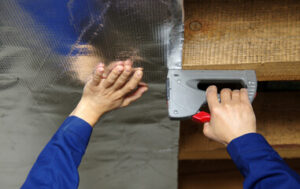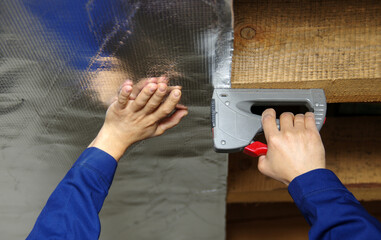Radiant Barrier Foil Houston helps save energy by stopping heat from entering the home during summer and retaining heat during winter. This will decrease your electric bills and help your HVAC system to work more efficiently.
 Radiation barrier foil is designed to reflect radiant heat while providing strength and durability. Unlike conventional insulation products, radiant barrier foil does not compress when handled.
Radiation barrier foil is designed to reflect radiant heat while providing strength and durability. Unlike conventional insulation products, radiant barrier foil does not compress when handled.
Installation
Radiant barrier is a thin, reflective foil that’s installed in an attic to control radiant energy. It keeps the attic cooler, allowing your air conditioning to work less and save you money on electricity bills. If your home is consistently hot, despite keeping the thermostat set to a low temperature, or if you’re spending too much on your energy bills, then radiant barrier might be worth investing in.
Radiants barriers can be draped between the rafters in new construction or they can be installed in existing homes during an attic update. In a new house, installers will drape the foil product between the rafters before the roof deck goes on. They may also install it after the roof is finished by stapling it to the attic floor over the existing insulation. For either method, the foil surface should be facing downwards to minimize dust accumulation on the reflective side.
Before you begin installing a radiant barrier, check your attic for moisture and repair any leaks or damaged areas. Also, make sure to work in the attic only when temperatures are moderate and be very careful where you step. If you fall through the ceiling, it could be dangerous and costly to fix. It’s also a good idea to work with a friend, as it will go faster and help prevent accidents.
Once a radiant barrier has been installed, it will keep the attic cooler and allow your blown in insulation to perform better. It’s important that you pair it with a traditional insulation like cellulose, fiberglass or foam to get the most benefit.
If you don’t pair the radiant barrier with a traditional insulation, heat will transfer through the attic floor and into the living space. You can then use a dehumidifier to pull the moisture out of the air, which can lead to fungal growth and health problems.
It’s best to have a professional install your radiant barrier, but if you do decide to DIY, it’s important to follow the instructions and be careful. Especially when working with insulation, you must be very careful not to compress it or leave gaps. The gaps will allow moisture to enter and cause damage to the structure of your attic, which can be expensive to repair.
Repair
Radiant barriers consist of aluminum foil that’s applied to one or both sides of a number of substrate materials including plastic films, kraft paper, cardboard, and oriented strand board. They can also be combined with other types of thermal insulation materials. Some radiant barriers are fiber-reinforced to increase durability and ease of handling. When properly installed, a radiant barrier prevents heat from being transferred through the ceiling into occupied spaces below. It can also reduce cooling costs and may even allow for a smaller air conditioning unit to be used.
If you have a home in a hot climate or have attic ductwork, a radiant barrier can be an affordable energy efficiency solution. It keeps the attic cooler and can save up to 10% in cooling costs according to the Department of Energy. However, a radiant barrier is usually less effective in cool climates and should be complemented by additional thermal insulation.
When installing radiant barrier, it’s important to make sure the foil surface faces downward so that dust doesn’t accumulate on it over time. Additionally, it’s important to check for any signs of moisture in the attic and eliminate it before applying the radiant barrier. Finally, it’s important to note that radiant barrier installation is a multi-person project. If you’re installing the radiant barrier over existing insulation, it’s important to pull the sheets taut after stapling them so that they don’t sag between rafters.
While many consumers are misled into thinking that radiant barriers with more layers are better than others, the truth is that it’s not the number of layers that makes a radiant barrier superior. The quality of a radiant barrier depends on its strength, flammability, water vapor permeability, and other qualities. Always look for a radiant barrier with current ASTM testing results to ensure that you’re getting the best product available.
A radiant barrier can also improve the performance of your existing attic insulation. This is particularly true in a home with an open-ridge attic. The radiant barrier will help to reflect the sun’s heat back into space, reducing the temperature of the roof cavity interior from 160°F to a more comfortable 100°F and saving you money on your energy bills.
Maintenance
If you want to save money on energy bills by keeping your home cooler and cutting back on air conditioner usage, a radiant barrier may be the answer. However, there are a few things you need to keep in mind before deciding on radiant barrier installation.
First, consider the climate in your area and how you use your home. An attic radiant barrier will reduce cooling costs by deflecting the sun’s heat rays rather than absorbing them as typical thermal insulation does.
Unlike traditional fiberglass batt insulation, radiant barriers are typically made of foil. This makes them more effective at reflecting solar rays than traditional foam. However, they do not provide the same R-values that standard insulation does. Foil radiant barriers are available as sheets that can be slid under the roof sheathing or placed on top of existing insulation. They can also be spray-applied, which is sometimes the preferred method when working with older buildings.
Before installing a radiant barrier, be sure to clean the area and check for signs of moisture. Moisture can cause a ceiling to leak and degrade the effectiveness of the insulation. It is also important to make sure that your attic ventilation is adequate. Insufficient ventilation can result in moisture build-up that can lead to fungal growth and lower the efficiency of your attic insulation.
In addition, be sure to check your attic for clogged ridge vents, gable vents and soffit vents. These can restrict the flow of air through your attic space and limit the benefits of a radiant barrier.
Another consideration is the shape of your attic space. If your attic floor is used for storage, radiant barriers can become susceptible to dust accumulation and are less effective than if they are slid under the rafters. Finally, it’s a good idea to have any recessed lights or other items that are located above your attic installed before you install a radiant barrier.
If you’re thinking about radiant barrier installation, contact the Temple professionals at FIX IT! We’ll inspect your attic space and give you options to help you reduce your energy bills. We can also provide duct cleaning and blow-in insulation for additional energy savings.
Replacement
The process for incorporating radiant barriers into a new home differs slightly from the process of replacing older insulation, but either option can help homeowners save money on their energy bills. In a new home, an installer typically drapes a rolled foil radiant barrier with its reflective faces down between the roof rafters before applying the attic floor sheathing. This helps to minimize the amount of dust that will settle on the reflective surfaces. For existing homes, contractors can install a radiant barrier by stapling the material to the bottom of the rafters from the inside of the attic or by placing it on top of the attic floor insulation.
Radiant barriers are primarily effective at reducing summer heat gain, but can also reduce heating costs during the winter. They are designed to reflect radiant energy away from the attic and into the air space between the rafters, but they don’t have the R-value of traditional thermal insulation materials.
To be effective, a radiant barrier must have its reflective surface facing an open air space with a substantial temperature difference between the roof deck and shingles. It must also be perpendicular to the sun’s radiant energy and strike it at a relatively low angle in order to effectively reduce solar heat. When it’s sandwiched between shingles and the roof sheathing without this air gap, it becomes a heat conductor rather than a radiant barrier and will actually cause cooling costs to increase.
When comparing radiant barriers, look for products with the highest possible fire ratings (Class A or Class 1) and a high reflectivity rating. The reflected energy should be 95-97%, but the emittance should be no higher than 3-5%. Also, be sure to purchase a breathable radiant barrier. A breathable radiant barrier has a middle layer of tightly woven fabric that makes the product stronger and allows moisture vapor to pass through.
For best results, combine radiant barriers with other types of attic insulation to achieve the desired R-value for your home. Radiant plywood barriers keep the attic cooler before the heat reaches your blown-in insulation on the attic floor, which can help to significantly reduce cooling costs in hotter climates.
